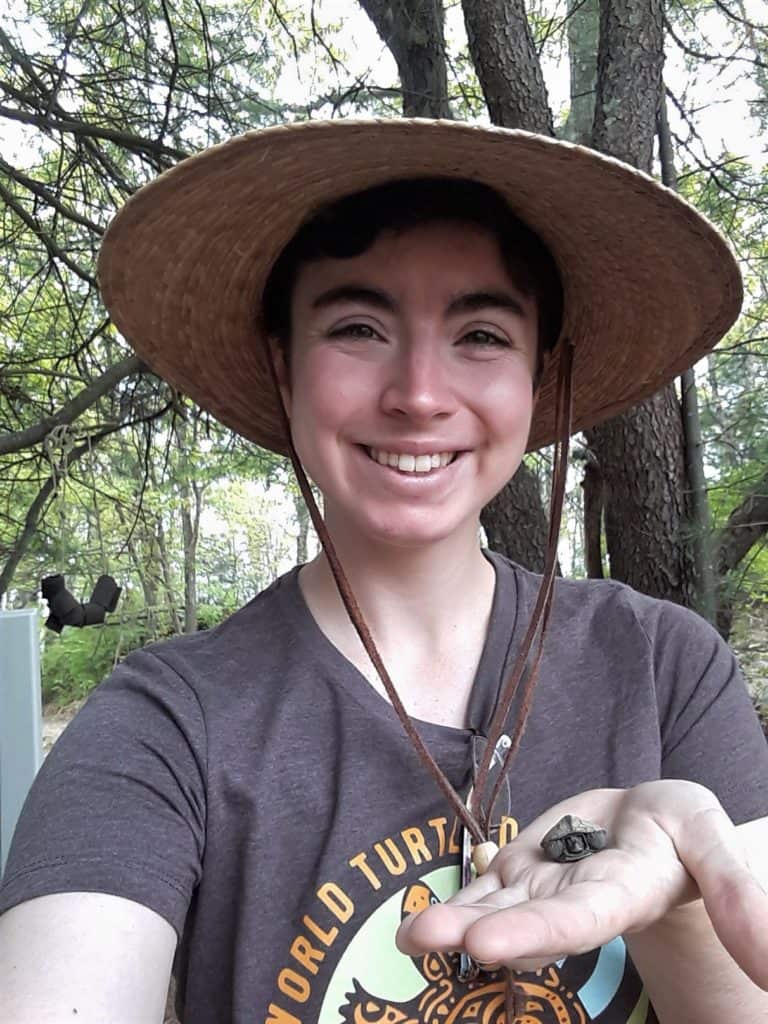Share this article
Wildlife Vocalizations: Carolyn Decker
Wildlife Vocalizations is a collection of short personal perspectives from people in the field of wildlife sciences.
On May 1 in Rhode Island, it was still chilly and overcast — the spring of 2020 was slow to warm. I was feeling lucky to continue my field work amid the COVID pandemic, working alone in the field, sweeping the habitat for any sign of the hatchling diamondback terrapins (Malaclemys terrapin) I was tracking. Since October, all have remained hidden, buried under the sand and leaf litter in their overwintering sites. Now, in spring, I wondered: Would I see them again, survivors of the long brumation period, fed by nothing but the remnant energy in their yolk sacs? Or, would I find only their predated remains?
For the last thirty years, local community science volunteers have monitored the nesting female terrapins of this population, protected their nests, and counted the emerging hatchlings. But no one knew where the hatchlings of this state endangered species went next. Such small and cryptic animals proved too elusive to monitor effectively. Did the hatchlings stay on land? Did they go immediately to the marsh? Without scientific evidence to guide the refuge’s terrapin management practices, decisions about hatchlings were based on anecdotes and well-intentioned guesswork.
How did management practices at this wildlife refuge need to change to better protect terrapins, including hatchlings? It was my job to find out.

Carolyn Decker, a University of Rhode Island master’s student, uses radio telemetry to search for tagged diamondback terrapin hatchlings in Rhode Island to learn about hatchlings’ post-emergence movements and habitat use. August 31, 2019. Credit: Pete McCalmont
For months, I had wandered the marsh and the adjacent upland with my radio telemetry equipment and my PIT tag sweeper shaped like a metal detector. When I chatted with visitors to the refuge, many assumed I was treasure hunting, and in a way, they were right. Whenever I homed in on the signal from the hatchlings’ tiny radio transmitters, I felt rich, tantalized by the mysteries of these wild animals and their wild places.
In addition to the tagged hatchlings I tracked over the fall, winter and spring, I continued to check known terrapin nest sites. Despite efforts to protect these nests, no hatchlings had emerged from them last summer. Based on the work of other terrapin researchers, I wondered whether some hatchlings might still be in that natal nest cavity, remaining in the dark since the moment they hatched out of their eggs nine months prior. Or had they perished any number of ways, or never developed? Without disturbing the nest, there was no way to know. So, I watched, and waited for spring.

Carolyn Decker, a University of Rhode Island masters student, holds a diamondback terrapin hatchling found during her research on terrapin hatchling post-emergence movements and habitat use in Rhode Island. May 23, 2020. Credit: Carolyn Decker
Midmorning on May 1, I saw a quarter-sized hole in the sand. Peering into the hole, I notice a brown pencil-eraser-like lump wiggling back and forth. At last, the hatchlings that had indeed overwintered in this nest are emerging, and I was there to witness it! The hatchling raises a forelimb shaped like a deflated corn kernel and wipes across its head. The black bead of an eye opens to see the bright gray world for the first time.
Six hatchlings emerged from nest #30 that day. I measured them, photographed them, and watched them wander off toward the salt marsh. Hopefully, with more luck and good management, they will grow and live long productive lives.
Learn more about Wildlife Vocalizations, and read other contributions.
Submit your story for Wildlife Vocalizations or share the submission form with your peers and colleagues to encourage them to share their story.
For questions, please contact Jamila Blake.
Header Image: A hatchling diamondback terrapin that overwintered in its nest and emerged in spring views the world beyond its nest for the first time. May 1, 2020. Credit: Carolyn Decker








